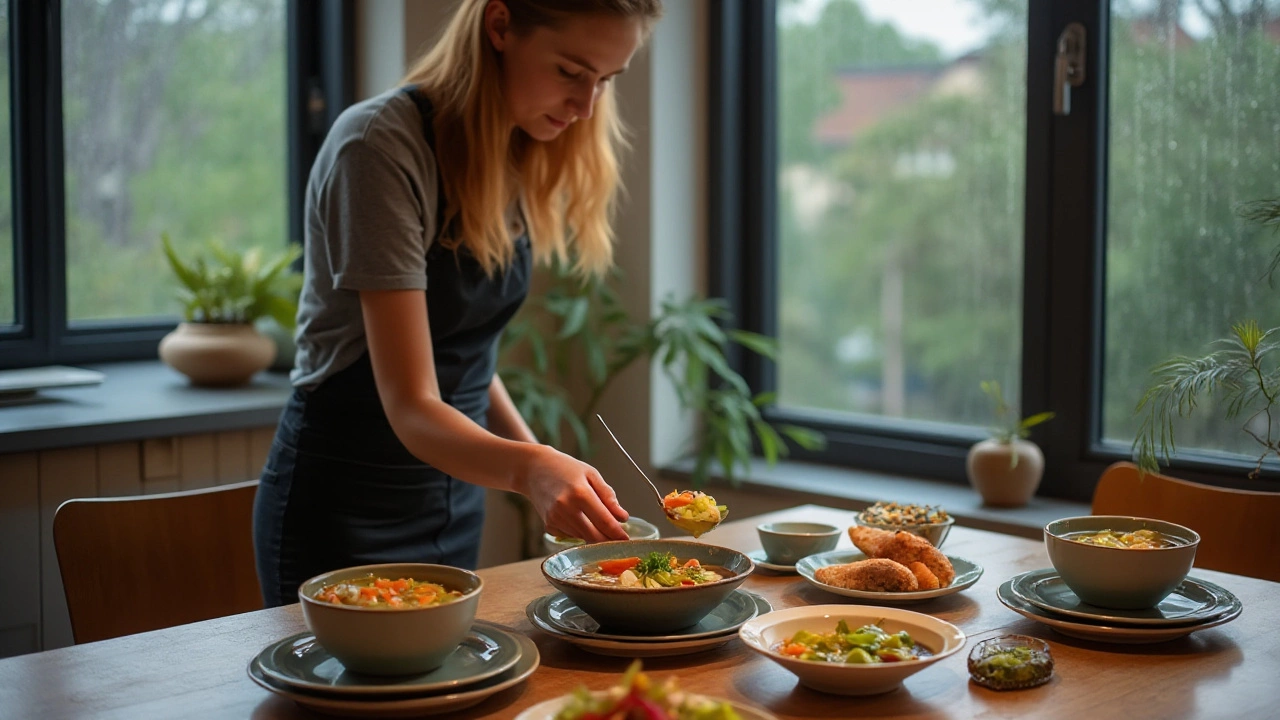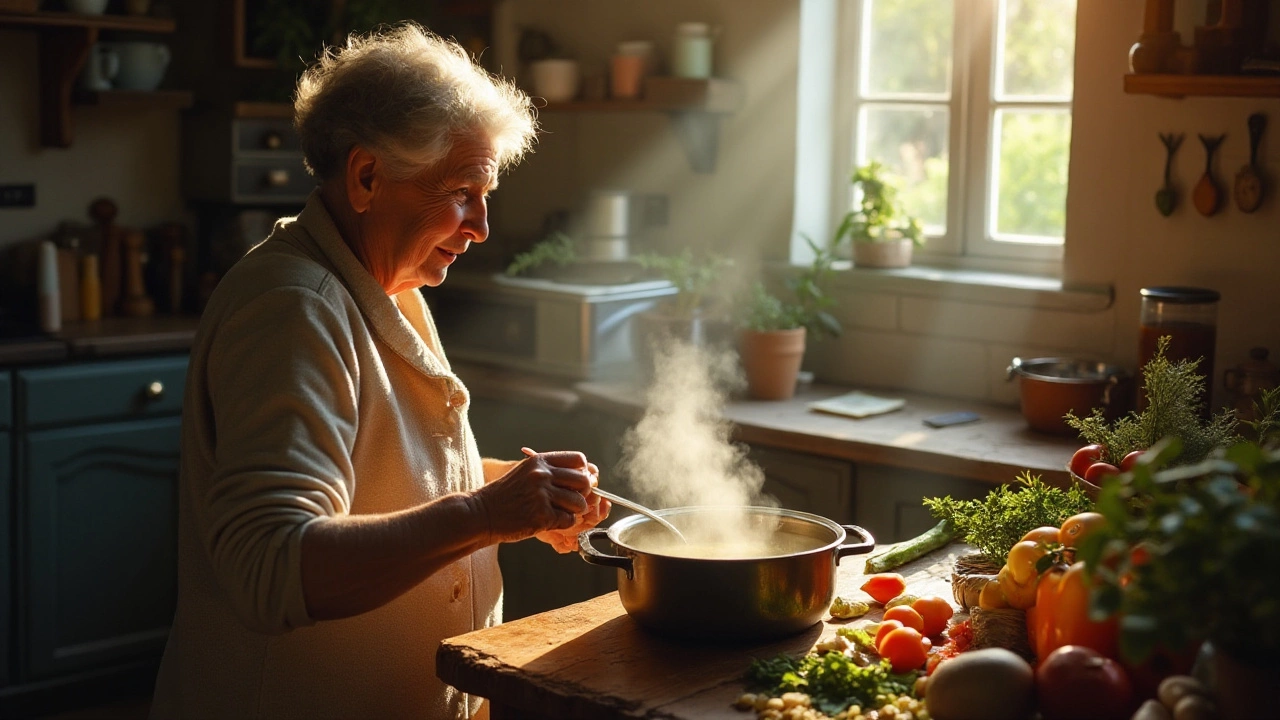When illness strikes, our cravings often lean towards foods that offer more than just nutritional value—foods that soothe and heal. Comfort foods, renowned for their heartwarming qualities, take on an even more significant role during such times. They promise a little reprieve from the discomfort of sickness and often bring nostalgic memories of home-cooked meals.
This article dives deep into the heart of comfort during sickness, exploring both classic dishes and inventive spins on time-honored recipes. From the soul-satisfying warmth of a rich chicken broth to the stomach-calming properties of ginger-infused teas, these foods aren't just about taste; they are about feeling good.
We also share confidence-boosting tips for whipping up these meals, even if cooking isn't your forte. Whether for yourself or a loved one, these ideas aim to bring a bit of warmth and joy to the wet, chilly world outside your door.
- The Science of Comfort Food
- Classic Comfort Recipes
- Modern Takes on Healing Dishes
- Tips for Creating Comforting Meals
The Science of Comfort Food
Comfort foods possess an almost mystical quality that transcends their nutritional components, tapping into our psychological and emotional needs in profound ways. The origins of comfort food are often linked to nostalgia and familial bonds, with these meals frequently serving as edible hugs from our past. Many of us seek these foods during illness because they are entwined with intimate memories of being cared for by loved ones, providing a sense of security and warmth amidst uncertainty.
The connection between food and mood is not merely anecdotal; scientific studies have delved into this phenomenon. Comfort foods often contain compounds that trigger the release of neurotransmitters like serotonin, which is known for its mood-boosting properties. Ingredients like chocolate and carbohydrates can activate our brain's reward system, providing both a sense of well-being and a psychological uplift. The effect is so tangible that researchers sometimes refer to these foods as having a pharmaco-nutritional impact.
"Comfort food wisely or unwisely turns back the clock. It's the taste of childhood on the fork," suggests food historian Bee Wilson in her book. This quote encapsulates the deep-rooted psychological aspects of how these foods affect us.
But it's not just about emotional comfort; the body's immune responses may benefit from these foods too. For instance, chicken soup, often coined as 'Jewish penicillin,' contains cysteine, an amino acid released from chicken during cooking. This compound resembles medications used to treat bronchitis and other respiratory conditions by thinning mucus in the lungs. Such healing recipes do more than appease the soul—they have tangible health benefits as well.
Moreover, the textural quality of comfort foods plays a critical role. Many popular choices are soft and easy to digest, fulfilling physiological needs when the digestive system demands something gentle. Wholesome porridges, rich stews, and smooth broths are staples because they require minimal effort to consume and digest, making them ideal when illness diminishes appetite and energy.
In a nutritional sense, these foods often strike a balance between protein, fats, and carbohydrates, aligned with what our bodies crave during recovery. The warmth of a comfort food dish also plays into thermoregulatory responses; warm foods can assist the body in maintaining an ideal temperature, providing physical comfort alongside emotional relief. Understanding this intricate dance between body and food underscores the profound importance of comfort food during times of ailment and recovery.

Classic Comfort Recipes
In the realm of comfort food, few things bring warmth and nourishment like the classic chicken noodle soup. This quintessential dish, often dubbed 'Jewish penicillin,' is hailed across cultures for its simple, healing properties. A steaming bowl of homemade broth loaded with tender chicken pieces, hearty noodles, and vibrant vegetables doesn't just fill the belly, it also nurtures the soul. The gentle steam rising from the bowl works its magic on clogged nasal passages, while the warmth soothes a scratchy throat. To make this comforting bowl, you begin by simmering a whole chicken or chicken pieces with onions, carrots, celery, and seasonings in a large pot. After hours of love and patience, strain the broth, return the chicken and vegetables, add noodles, and cook until they are tender. Serve hot, seasoned to taste, perhaps with a squeeze of lemon or a sprinkle of fresh herbs.
Another beloved classic is the creamy mashed potato, the very embodiment of simplicity and comfort. Its texture, smooth and buttery, is like a warm hug. Mashed potatoes find their way onto hospital trays for a reason; they are easy to digest and provide a gentle source of energy. Preparing mashed potatoes isn't just about boiling and mashing, it requires care. Selecting the right kind of potato, often the Yukon gold variety, ensures that the final dish is creamy and not gluey. After boiling the peeled and cubed potatoes until tender, drain them well, then return to the pot with generous amounts of butter and a splash of cream or milk. Mash until your desired consistency, seasoning with salt, pepper, and a whisper of nutmeg for depth. This humble dish can stand alone or serve as a decadent side on any dinner table.
Proust famously wrote, "The smell and taste of things remain poised a long time, ready to remind us... the immense edifice of memory." Such is the power of comfort foods, to transport us back to times when we felt safe and sound.
In the land Down Under, our grandmothers knew the secret to comforting a child was a bowl of hearty stew. Whether it be beef, lamb, or a vegetarian version, stews are the backbone of Australian winter cuisine. These thick, savory dishes, slow-cooked to perfection, reflect the essence of patience and skill. Start with the trifecta of flavor: sauté onions, carrots, and celery. Add chunks of meat, browning them to lock in flavor. Pour in stock, a splash of wine if available, and toss in potatoes and root vegetables. Simmer for hours until the meat is meltingly tender, the vegetables softened and have absorbed the rich broth.
For those who enjoy a bit of sweetness during the healing process, a classic dessert like rice pudding offers a lovely treat. This dish, a staple in many cultures, combines rice's gentle texture with the warmth of milk, all scented with vanilla or cinnamon. It's an excellent choice for those recovering, as it’s easy on the stomach and quite fulfilling. To prepare, start by gently simmering rice in milk with sugar until it's soft and creamy. Stir in your choice of spices and perhaps a handful of raisins for added depth. Serve it warm, comforting enough to bring a smile with each spoonful. Cooking is an art in itself, though the recipes are simple, the feelings they evoke are anything but.

Modern Takes on Healing Dishes
The landscape of comfort food, especially during times of illness, is ever-evolving. While traditional recipes have held their ground as steadfast champions of recovery, modern culinary innovation introduces exciting and nurturing alternatives that promise to make us feel better while delighting our taste buds. These contemporary healing dishes take advantage of today's nutritious trends and culinary creativity to bring new dimensions of flavor and health to the classic idea of comfort food.
One intriguing development in modern healing foods is the inclusion of superfoods and plant-based ingredients. Quinoa, for instance, has largely replaced rice in some dishes due to its high protein content and myriad nutrients like magnesium and iron, which are essential while recovering. Similarly, the spike in popularity of kale and spinach has seen these leafy greens integrated into warm, comforting broths and soups, providing vital vitamins and minerals that the body craves during illness. Healing recipes aren't just limited to traditional chicken soups anymore; they now include miso soup enriched with seaweed—a dish that's not only high in antioxidants but also soothingly warm for when you're feeling under the weather.
Another creative twist in modern comfort food is the delightful use of herbs and spices renowned for their medicinal properties. Turmeric lattes, for example, have gained prominence not only for their comforting warmth but also for their anti-inflammatory properties. Ginger has also been a popular addition, known for its ability to calm upset stomachs and ease nausea. Dishes incorporating ginger, such as ginger-infused congee or vegan ginger-carrot soup, have become staples in the repertoire of home chefs looking to ease their ailments through food.
Chef Yotam Ottolenghi notes, "Flavor is often the vehicle for introducing health-benefiting ingredients. A bit of spice, a hint of lemon—it all plays into the art of healing meals."
Innovation doesn't stop at the ingredients level; preparation methods have also become more ingenious. The rise of pressure cookers and slow cookers in contemporary kitchens has made it significantly easier to produce dishes like stews and curries, which maintain their nutritional integrity while offering a profound depth of flavor. These methods allow for tenderness and infusion of flavors, transforming a simple chickpea stew into a delectable healing powerhouse dense with garlic and turmeric.
While creativity inspires these new recipes, accessibility often drives their popularity. In a world increasingly considerate of dietary diversity, options abound for those observing vegan, gluten-free, or low-sugar diets even when seeking out food for recovery. The incorporation of nut milks or almond flour as substitutes in creamy dishes ensures that everyone can enjoy some much-needed sustenance without worry.
With thoughtful inclusiveness and inventive approaches, these modern healing dishes not only fulfill the need for sustenance during illness but also cater to modern palates. As our understanding of nutrition continues to deepen, we can anticipate a bright future brimming with flavorful possibilities—each dish a small, comforting step on the road to recovery.

Tips for Creating Comforting Meals
Creating comfort food for the sick is an art that blends simplicity with intuition. The essence of such meals lies in their nurturing nature, and the uncomplicated way they glide down the throat, warmed with the simplicity of their ingredients. Let's start with the foundation—a powerful broth. Bone broth, for instance, is loaded with minerals that support the immune system, and it acts as a natural healer. A slow, gentle simmer extracts these vital nutrients, offering a rich, flavorful base that you can sip as a tea or use to create heartier dishes. An often-cited study from the University of Nebraska Medical Center highlighted how chicken soup, in particular, may have anti-inflammatory properties, which help ease symptoms of colds and flu.
"What is there more kindly than the feeling between host and guest?" — Aeschylus.
Textures play a vital role in these meals; soft, easily digestible foods often reign supreme. Think along the lines of silky mashed potatoes enriched with cream and butter, or rice congee, which is a traditional Asian porridge soothing in both flavor and texture. The goal is to ensure each bite is tender and comforting. Soft foods not only ease digestion but also create a sense of safety and warmth, much like a hug from within.
Fresh Ingredients for a Nutritious Boost
Freshness is key when preparing dishes that heal. Seek out vibrant vegetables such as carrots, leafy greens, and squashes packed with vitamins and antioxidants. Herbs like ginger and garlic provide a robust medicinal punch, both known for their immune-boosting properties. Adding these to your meals enhances flavor and nutrition without overwhelming the delicate balance that comfort dishes strive to maintain. According to various holistic nutritionists, incorporating these natural ingredients can speed up recovery and offer energy boosts essential during illness.
When thinking of creating soothing meals, consider texture, temperature, and tenderness. In many cultures, warmth is symbolic of love and care, and this extends to the meals we prepare. Ensure your comfort recipes are served warm, perhaps not piping hot, to avoid any irritation to sore throats. Soups, stews, and gentle teas top the comfort food chart for good reason—they're easy to consume and packed with the power to heal. With these considerations, you'll not only create delicious, comforting dishes but also provide invaluable care and nurturing to those who need it most.
Lastly, always listen to feedback from your diners. Preferences change particularly when one is unwell, and adapting to their needs will make your meals not only delicious but truly comforting. A spoonful of honey or a pinch of extra salt might just make all the difference in delivering that perfect bite. With the right touch of personal attention and love, every dish can transform from a meal to a memory of warmth on a cold day. Create, taste, and most importantly, share these healing recipes not just with those in need but anyone who values the tender embrace of home-cooked comfort food.

